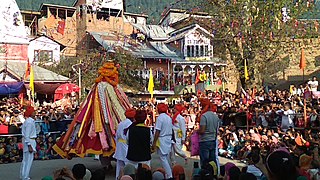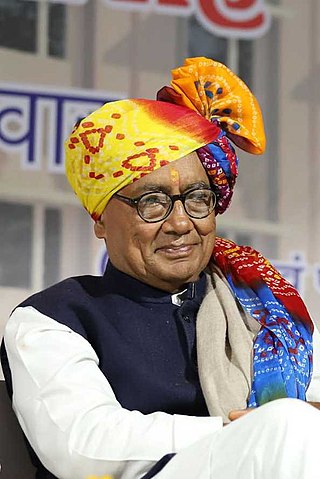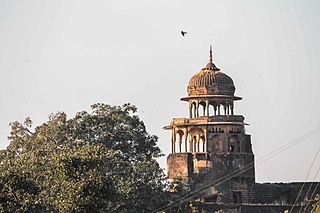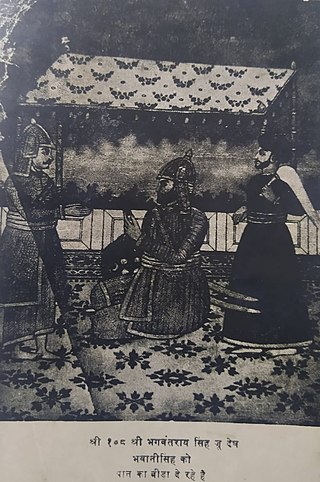
Alwar is a city located in India's National Capital Region (NCR) and the administrative headquarters of Alwar District in the state of Rajasthan. It is located 150 km south of Delhi and 150 km north of Jaipur.

Chauhan, a name derived from the historical Chahamanas, a clan name associated with various ruling Rajput families in the present-day Indian state of Rajasthan from seventh century onwards.

The Kachhwaha is a Rajput clan found primarily in India.

Bhaderwah or Bhadarwah is a town, tehsil, and sub-district in the Doda district of Jammu Division of Jammu and Kashmir, India. Bhaderwah Valley is famous for it's beauty, nature. Bhaderwah valley is known as 'Land Of Snakes'. Bhaderwah is also a land of fairs and festivals like Mela Pat, Subar Dhar Mela, Kud dance, Pahari folk songs and music. It also has heritage sites like the Fort, hundered years old mosque and an ancient Vasuki Nag Temple.

Digvijaya Singh is an Indian politician and a Member of Parliament in the Rajya Sabha since 2014. He is a senior leader of the Indian National Congress and Ex-General Secretary of the Indian National Congress party's All India Congress Committee. Previously, he had served as the 14th and 15th Chief Minister of Madhya Pradesh, a central Indian state, in two terms from 1993 to 1998 and from 1998 to 2003. Prior to that he was a minister in Chief Minister Arjun Singh's cabinet between 1980 and 1984. In 2019 Indian general election he was defeated by Pragya Singh Thakur for Bhopal Lok Sabha seat.
Raghogarh-Ruthiyai or Raghogarh-Vijaypur is a town and municipality in Guna district in the Indian state of Madhya Pradesh.

The Kingdom of Amber, later the Kingdom of Jaipur or the Jaipur State, was located in the north-eastern historic Dhundhar region of Rajputana and was ruled by the Kachwaha Rajput clan. It was established by Dulha Rai, possibly the last ruler of the Kachchhapaghata dynasty of Gwalior who migrated to Dausa and started his kingdom there with the support of Chahamanas of Shakambhari with coalition of Gaur dynasty of sheopur in the 12th century. Mostly through 12th to 15th century, the kingdom faced stagnation, sources were scarce. Under its ruler, Raja Chandrasen of Amber became a Sisodia vassal and fought in the Battle of Khanwa under Raja Prithviraj Kachhwaha.
Rajasthani literature is a tradition in Indian literature dating to the 2nd millennium, which includes literature written in the Rajasthani language. An early form of Rajasthani started developing in the 11th century from Saurseni Prakrit as Maru-Gurjar or Gurjar Apabhramsa. Early Rajasthani literature was usually written by Charans. Earlier Rajasthani was known as Charani or Dingal, which was close to Gujarati. Medieval Rajasthani literature was mostly heroic poetry mentioning the great kings and fighters of Rajasthan. Rabindra Nath Tagore, a Bengali polymath, once said, "The heroic sentiment which is the essence of every song and couplet of a Rajasthani is peculiar emotion of its own of which, however, the whole country may be proud". It is generally agreed that modern Rajasthani literature began with the works of Suryamal Misran, including the Vansa Bhaskara and the Vir Satsai. The Vansa Bhaskara contains accounts of the Rajput princes who ruled in what was then Rajputana, during the lifetime of the poet (1872–1952). The Vir Satsai is a collection of hundreds of couplets.

Raja Raisal, reigned 1584 to 1614, He married Chauhan Rajput Princess Kisnavati Nirban, the only daughter of Raja Peetha Nirban of Khandela and thus, was also the 1st Shekhawat Raja of Khandela. Son of Maharao Suja of Amarsar, was granted the estate (jagir) of 7 villages in Lamiya on death of his father, thereupon he joined Imperial Service at Delhi where he was granted the title of "Raja" also a title of "Darbari" and a Mansab of 1250 sawars which was later raised to 3000 by Emperor Akbar. He died about 1614 in South India. He was great-grandson of MahaRao Shekha, King of Amarsar and he belonged to the Kachwaha Clan of Amber/Jaipur Royal Family. The Shekhawats ruled over the Shekhawati region for over 500 years and are honoured with the hereditary title of "Tazimi Sirdars", whom the Maharaja of Jaipur receives by rising from his seat.
Kotharia is a town in Rajsamand district of Rajasthan, which was the headquarters of the former 1st class jagir (estate) of the House of Kotharia, part of the Udaipur (Mewar) state, which was in Mewar Residency in Rajputana Agency.

Maharao Chatra Sal or Shatru Sal (1632–1658) was one of the most prominent and illustrious ruler of Hada-Chauhan dynasty of the Kingdom of Bundi and a high ranking Mughal official at the imperial court of Mughal Emperor Shahjahan.He built the temple of Keshavrao at Kishorai-Patan and the marvellous Chatra Mahal in the upper storey of Taragarh Fort in the capital Bundi which also used to be the official residence of the rulers of Bundi.

Bundi State, founded by Hada Rao Devda, was a princely state in India. The former state was located in modern-day Rajasthan. It was ruled by Hada Chauhan Rajputs.
Ahirwada was a historic region located between the Parvati and Betwa rivers in Central India or modern Madhya Pradesh. It was between the cities Bhilsa and Jhansi. Historically Ahirwada was ruled by members of the Ahir community.

BajrangarhFort is located in Bajrangarh village of Guna District in the Indian state of Madhya Pradesh. The Bajrangarh fort lies at an altitude of 92.3 metres and is in ruins. The fort is about 10 kilometres from Guna on Guna to Aron road on the bank of Chapet river around 8 kilometres south-west of Guna city. It spreads over 72 bighas of land on a high hill. ,it was the headquarters of a mahal of the Chanderi Sarkar. During the reign of Raja Jai Singh, Daulatrao Scindia sent his General, John Baptiste to attack the fort in 1816 A.D. Raja Jai Singh was defeated and the fort was destroyed. The Bajrangarh fort had four gates in four directions. Inside the fort, Moti Mahal, Rangmahal, Ram Mandir, and Bajrang Mandir are still intact.

The State of Shahpura or Princely State of Shahpura was a princely state in Shahpura, Bhilwara during the era of British India. Its relations with the British were managed by the Rajputana Agency. The last ruler of Shahpura signed the accession to join the Indian Union in 1949.

Udaipur State was one of the princely states of India during the British Raj. The town of Dharamjaigarh was the former state's capital.

Jashpur State was one of the princely states of India during the British Raj. The town of Jashpur was the former state's capital. The rulers were Rajputs of the Chauhan clan.

Raghogarh State, also known as Raghugarh and Khichiwara, was a princely state of the Gwalior Residency, under the Central India Agency of the British Raj. It was a Thikana state of about 109km2 with a population of 19,446 inhabitants in 1901. The Parbati River marked the western border of the state. The capital was at Raghogarh in the present-day Guna district of Madhya Pradesh.
Delwara, nestled in the Aravalli Range hills, is a small town about 28 km away from Udaipur, Mewar, and close to Eklingji Temple, on the way to the temple town of Nathdwara, in the state of Rajasthan, India. Delwara was originally known as ‘Devkul Patan Nagri’, which means the town of god. It boasted over 1500 temples at one time, out of which there were over 400 Jain temples. Delwara was the center of learning and culture before the 15th century AD. Around the middle of the 13th century, Raja Sagar, a Deora Chauhan and a descendant of Rao Kirtipal of Jalore, was a very brave king of Delwara (Mewar). Descendants of Raja Sagar sacrificed their lives while fighting alongside Ranas of Mewar against Muslim invaders. Raja Sagar was the progenitor of Bachhawat and Bothra clans of Oswals. Sagar's son, Kunwar Bohitya was immensely influenced and inspired by Jain philosophy. Samdhar, a grandson of Bohitya and a Deora Chauhan, was the first man in his genealogy to convert to Jainism.

Raja Bhagwant Rai was an 18th-century Khichi Rajput ruler of Asothar and Ghazipur in the Fatehpur District of the Indian state of Uttar Pradesh. He is known for his resistance against the Mughal Empire and for establishing an independent state throughout his reign.















